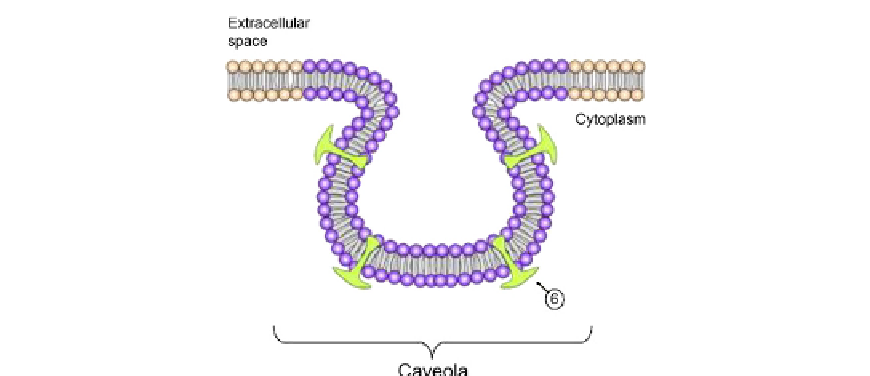Biology Reference
In-Depth Information
FIGURE 8.9
Caveolae, a type of lipid raft. Reproduced with permission
[31]
While the lipid raft story is compelling, it is wrought with potential problems. In fact rafts
have occasionally been referred to as 'unidentified floating objects' or UFOs. The cold
temperature detergent procedure is crude and very slow compared to the likely timescale
of lipid raft stability, and is full of potential artifacts. The older raft isolation procedures
are being improved and non-detergent methodologies have been developed (Chapter 13)
[27]
. The very small raft size, being below the classical diffraction limit of a light microscope,
has made direct observation of rafts very difficult. Raft size also brings into question their
stability. Even if lipid rafts exist, they may only occur on a time scale that is irrelevant to bio-
logical, diffusion-controlled processes.
One question that is not close to resolution is how many types of microdomains constitute
a functional membrane. While lipid rafts have garnered almost all of the attention, it seems
likely that there probably exist many types of undiscovered non-raft microdomains. Even the
lipid rafts may be composed of countless sub-raft domains. Currently two basic types of rafts
have been identified, planar lipid rafts (also referred to as non-caveolar, or glycolipid rafts)
and caveolae. Planar rafts are continuous with the membrane surface, while caveolae are
flask-shaped invaginations (
Figure 8.9
). Caveolae are easily distinguished from planar rafts
by their unique flask-shape and the presence of a characteristic protein, caveolin. In contrast,
planar rafts contain flotillin proteins. The function of both caveolin and flotillin is to attract
and retain signaling molecules into rafts. Other distinct types of raft and non-raft microdo-
mains will undoubtedly be discovered in the future.
SUMMARY
By 1935 basic elements were in place to propose a realistic membrane model. This was
accomplished by Danielli and Davson in their Pauci-Molecular model, based on a lipid
bilayer that had proteins uncomfortably attached in the form of a protein
lipid
protein
e
e



